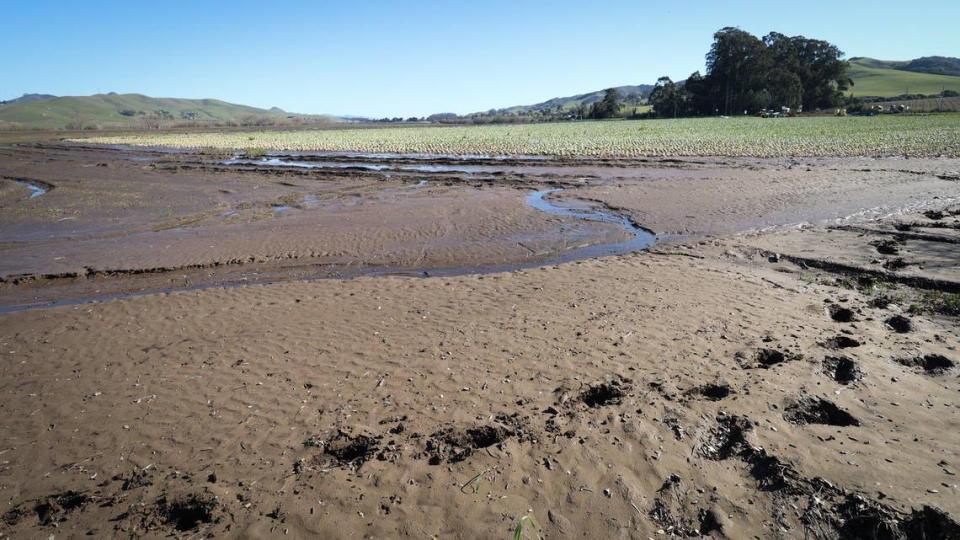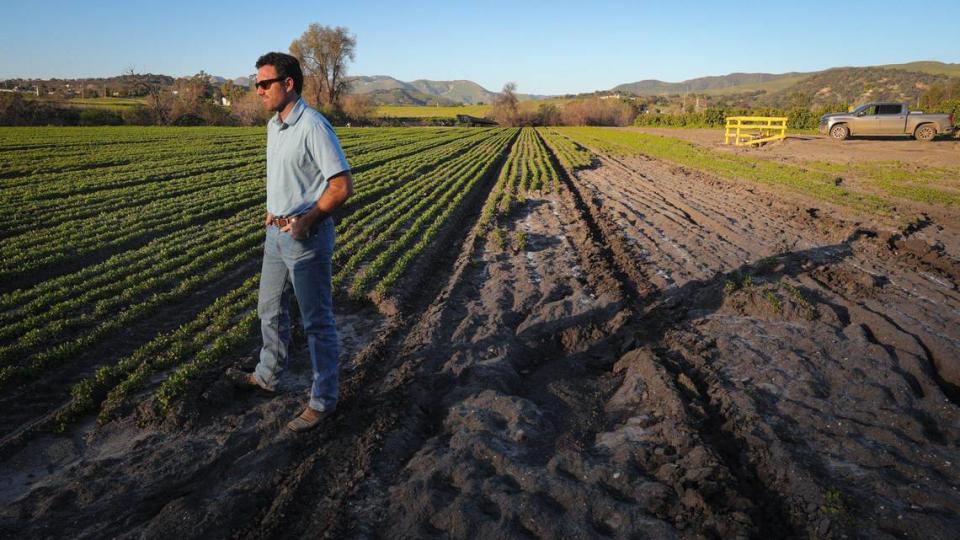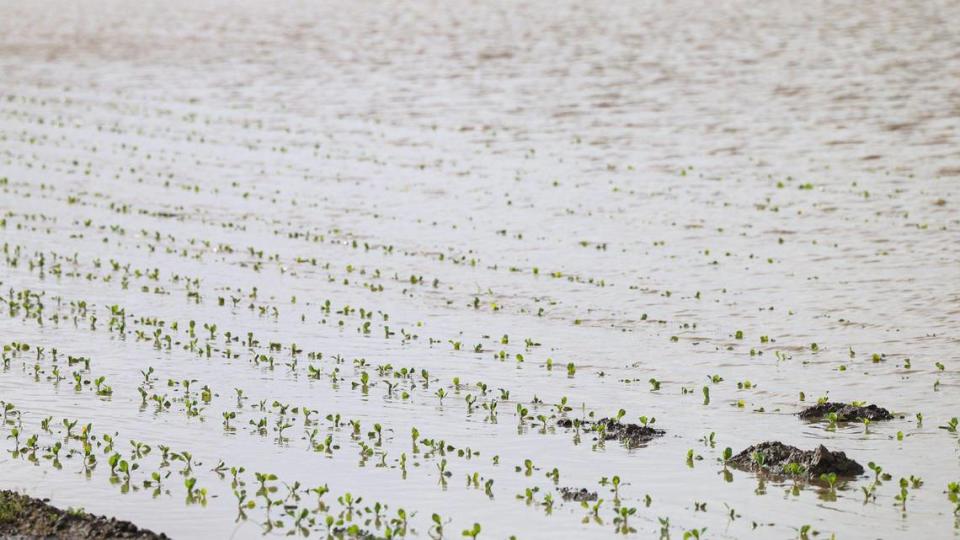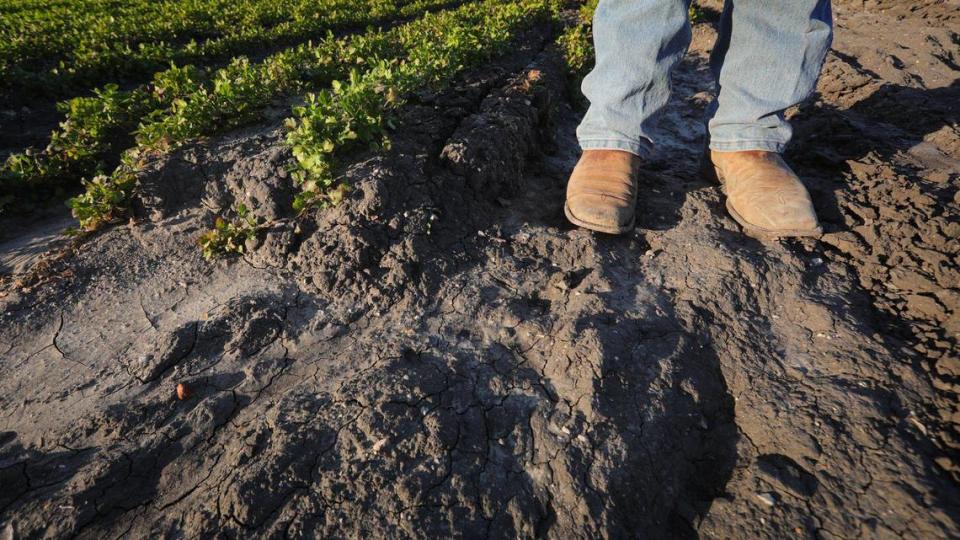SLO County farms suffer millions in losses from storms. But the real toll is unknown
In the fall, farmers prayed for rain.
And then it came — all at once.
“We just weren’t prepared for any of this,” said Dave Alford of Turri Ranch in the Los Osos Valley.
When the big January storm hit on the 9th and 10th of the month, Alford’s fields of cabbage flooded and disappeared under a new lake of water from the half-a-foot of rain that overwhelmed debris-clogged drainage ditches.
Now, the vegetables’ leaves are tinged yellow, a clear sign that the cabbage is too waterlogged and won’t make a quality product to market.
The devastating deluge impacted most farms in San Luis Obispo County: from the wine grapes in Paso Robles to the lettuces and strawberry fields in the South County.
Farms near rivers or in low-lying areas of the region were hit the worst, said Marc Lea, assistant agriculture commissioner for the county. There, entire crops were swept away or buried under several feet of water for days, he said.

“We’ve had reports of damage from all corners of the county,” Lea said. “If they were adjacent to some kind of creek or river that overflowed, or a levee that was damaged, those are the ones that have seen the main losses.”
By conservative estimates, the early January storm caused tens of millions of dollars in crop loss and tens of millions more in agricultural facility, building and land damage, according to Lea.
More accurate assessments are difficult to determine because of the long-term nature of the storm’s damage.

Farms devastated by storm’s deluge of rain
Sitting below Lopez Lake east of Arroyo Grande, Grant Talley of Talley Farms stood on the edge of a large field of cabbage in late January.
“This is going to be tough to recover from,” he said.
The field was devastated during the storm. An often-dry creek overflowed from its deep banks and carried plant debris, trash and several feet of water into Talley’s cabbage field.
The water washed away much of the fertile topsoil the farm had carefully maintained for years, and took it on a ravaging trip in a new river through the downhill fields of lemon trees and cilantro.
Irrigation lines were ripped away, and entire rows of cilantro are now missing.

“We prepared, definitely, but there was really nothing we could do once the rain started coming down,” Talley said. “We’re not going to have product when we need it.”
In the areas of Oceano and Arroyo Grande south of the Arroyo Grande Creek Levee, Tom Ikeda of Ikeda Brothers farming operations said they’re still pumping water from their fields of lettuce and cabbage.
The levee broke during the early January storm, causing evacuation orders and widespread flooding in the areas south of the normally tame creek. At one point, Ikeda said his more than 80 acres of farmland, along with all of his electrical groundwater pumps and irrigation equipment in the area, was under at least a few feet of water.
The roughly six acres of vegetable crops that had been planted earlier in the winter should have been harvested soon, but now likely won’t meet food safety standards because of the new pollutants and diseases brought in by the floodwaters, Ikeda said.

“It’s something we were counting on,” Ikeda said of harvesting the crop. “It’ll probably mean a loss of around $15,000 to $20,000.”
Another 70 to 80 acres of unplanted fields are also still oversaturated from the storm, Ikeda added.
Those fields will have to lay empty longer than normal to dry out and be tested for diseases and pollution, Ikeda said. That’ll delay when he can plant the foods desired by hungry mouths year-round.
“In our country, our customers are looking for a steady supply,” Ikeda said. “Now, we’re going to have a gap in product.”

Financial aid available for farmers
Farmers can apply for federal relief money from the United States Department of Agriculture’s Farm Service Agency. That’s thanks to President Joe Biden’s disaster declaration that freed up funds for those impacted by the storms.
The funds can be used to help cover damage, including compensating for lost crops, replacing broken fences and irrigation systems and re-leveling fields.
The system, however, is complicated to navigate.
First, farmers had to delay major repairs on facilities and fields to document the damage and have a Farm Service Agency official confirm the extent.
Then, they have to figure out which grants and funds to apply for.

“What’s going to help me with the topsoil I lost? Or what about the fences I lost?” asked Alford of Turri Ranch. “There are so many hoops to jump through. It can be very frustrating and confusing.”
Brent Burchett, executive director of the San Luis Obispo County Farm Bureau, has been one key figure in the county helping farmers navigate the difficult federal funding system.
He’s helped direct farmers to the right agency that may be able to help them get funds.
“My advice right now is sometimes whatever the person may say, if it doesn’t sound right to you, ask it again. Call the office later and follow up,” Burchett said. ”You may go to the Small Business Administration booth, they may say, ‘No, that’s not covered.’ You go to a USDA booth, and maybe it is covered.”
Farmers who need disaster relief funds should visit the disaster recovery center at the San Luis Obispo Veteran Memorial Building at 801 Grand Ave. in San Luis Obispo, Burchett said. There, they can find information booths staffed with employees from agencies such as the Federal Emergency Management Agency, USDA and the U.S. Small Business Administration.
The disaster recovery center is open 8 a.m. to 7 p.m., seven days a week.
Burchett encouraged farmers to be patient during the long and often frustrating financial aid process. After all, the funds may help them sustain their business and continue feeding the nation.
“This is all on top of all the other farming challenges: Getting enough labor, getting pallets, cardboard boxes, we still have those kinds of supply chain problems,” Burchett said. “Just one more thing to challenge farmers, but luckily they’re resilient.”


